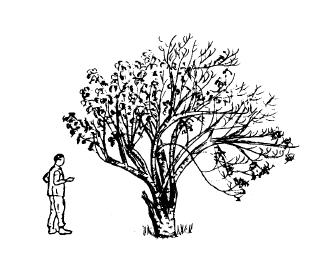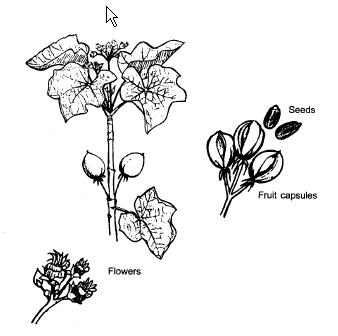Geographical Distribution of Jatropha curcas in Africa (red marked), source ICRAF. Updated on 27th March 2019.
Introduction
Geographical distribution:
One of more than 150 Jatropha species, mainly occuring in tropical America and Africa. This species was introduced to Africa centuries ago and is now naturalized in drier areas in many countries. A decorative plant frequently planted as a live fence around homesteads or used as a boundary or grave marker. Also naturalized in bushland and along rivers in the western, central and coastal parts of Kenya and in western and southwestern lowlands of Ethiopia. Agroclimatic Zones II - III.
Description
An erect, stiffly branched succulent shrub or small tree 3-4 m.
Bark: Thin and yellow-grey with a papery peel; an unpleasant milky sap when cut.
Leaves: Alternate and simple with 3-5 shallow lobes, to 15 cm long, widely rounded at the base on a stalk to 16 cm.
Flowers: Small, yellow-green, shortly stalked on branched heads with a shorter stalk than the leaves.Fruit: Ovid capsules, slightly three-angled 2.5 - 4 cm long, yellow when ripe dark when hardening, contain 3 mottled blackish thin-shelled oblong seeds that measure 20 mm by 12 mm. When crushed the seeds produce 35 - 37 % yellow oil.
Fruit: Ovid capsules, slightly three-angled 2.5 - 4 cm long, yellow when ripe dark when hardening, contain 3 mottled blackish thin-shelled oblong seeds that measure 20 mm by 12 mm. When crushed the seeds produce 35 - 37 % yellow oil.
 |
| Jatropha curcas |
|
© P. Maundu and B. Tengnäs, World Agroforestry Centre |
Propagation and Tree Management
 |
| Jatropha curcas |
|
© P. Maundu and B. Tengnäs, World Agroforestry Centre |
Uses:
Oil from seeds is used for making soap and lighting lamps. Latex contains Jatrophine which has anti-microbial and anti-fungal properties; also used an ointment against skin disease, rheumatism and for sores in livestock. Bark yields dark blue dye. Twigs are used for brushing teeth. Leaf from juice used for treating external piles. Decoction of leaves used against cough and as an antiseptic at birth. Sap is used to treat wounds and bleeding and roots are reported to be used as an antidote for snakebites. The whole plant is used as live fence, boundary marking, ornamental.
Propagation:
Seedlings, cuttings.
Seed:
Collect when capsules split open. About 2,400 seeds per kg; germination rate 70- 100%. Dried seeds are soaked in cold water overnight and then sown directly onto seedbed. Germination takes place in 12-15 days.
Treatment:
Do not dry fruits on roasting surfaces if for planting. Store them for 3 months before use to break primary dormancy; but use them before 15 months. Store seeds in low moisture.
Storage:
Seeds are oily and do not store for long. Storage in dry-air condition with moisture content <5% is preferred.
Management and Remarks
Remarks: The name Jatropha comes from Greek words meaning physician and food. The oil has purgative properties; seeds are toxic and should not be swallowed. Even the remains pressed from seeds can be fatal.
Information Source Links
- Bekele-Tesemma, B. (2007). Useful trees and shrubs for Ethiopia. World Agroforestry Centre, Nairobi, Kenya. ISBN 92-9059-2125
www.worldagroforestry.org - ICRAF, Jatropha curcas www.agroforestry.org
- Maundu, P. and Tengnäs, B. (2005). Useful trees and shrubs for Kenya. World Agroforestry Centre. ISBN: 9966-896-70-8
www.worldagroforestry.org
